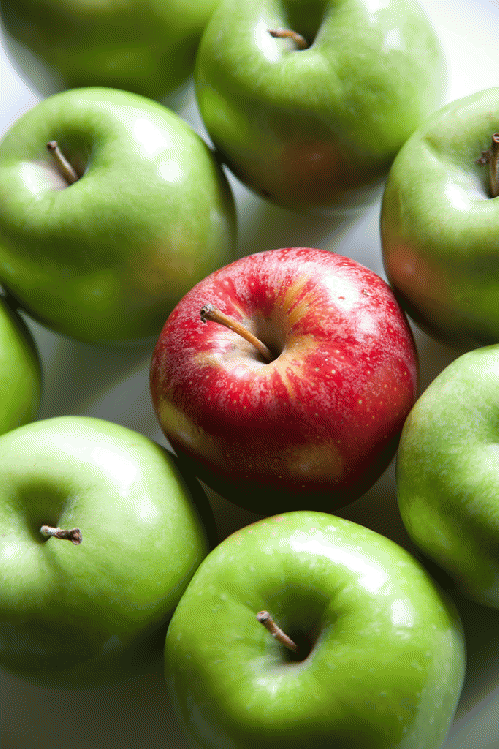Implicit bias refers to bias in judgment that operates without
intentional control and typically without conscious awareness. The
targets of implicit bias are generally groups toward which prejudice
used to be socially normative and acceptable but now is not. Thus, bias
against bullies is explicit rather than implicit, while there is strong
evidence of implicit bias against women, LGBT individuals, and
non-whites in a variety of different contexts. While awareness of
implicit bias has yet to reach either the general public or mainstream
psychology (e.g., Wikipedia's history of psychology timeline
makes no mention), those engaged in either scholarship or activism
concerning prejudice and inclusion are increasingly seeing implicit bias
as a vital part of their work.

Which apple do you want? When it comes to apple picking, we can be as biased as we like. In evaluating job candidates, we need to learn to recognize our biases and push them to the side.
(Image by Flazingo_photos) Details DMCA
Thus far, most research (and policy recommendations) has focused on the criminal justice system (both police and judges/juries) and health care services, but there is a growing awareness that implicit bias is also playing a role in hiring decisions, including at universities. For example, Steinpreis, Anders, and Ritzke (1999) modified an actual curriculum vita so that it either contained a female or male name and sent the CV to 238 randomly-selected academic psychologists who listed a university address in the 1997 directory of the American Psychological Association (APA). The researchers found that when the CV had a male name, the candidate was judged by both male and female evaluators to be worthy of hire approximately 73% of the time, compared to 45% of the time when the CV had a female name.
Notably, this bias is evident across academic departments, including in the sciences, where one might be tempted to believe that applications are more likely to be evaluated objectively. As just one example, Moss-Racusin, Dovidio, Brescoll, Graham & Handelsman (2012) found that
Similar findings emerge when researchers manipulate the apparent race of the job applicant. For example, Bertrand and Mullainathan (2003) sent job applications to a variety of different type of employers, altering the resumes systematically so as to manipulate both the quality of the resume and the apparent race of the applicant. The race of the applicant was manipulated only with the name on the resume, with some resumes displaying common African"American names such such as "Lakisha" or "Jamal", while others containing common white names, such as "Emily" or "Greg". They found that, despite having identical resumes, white applicants were called back approximately 50% more often than African"American applicants, regardless of industry or occupation. Furthermore, white applicants benefited more than African"American applicants when presenting a high quality resume, suggesting that the penalty for being African"American is actually greater for higher status jobs, such as university faculty.In a randomized double-blind study (n=127), science faculty from research-intensive universities rated the application materials of a student who was randomly assigned either a male or female name for a laboratory manager position. Faculty participants rated the male applicant as significantly more competent and hireable than the (identical) female applicant. These participants also selected a higher starting salary and offered more career mentoring to the male applicant. The gender of the faculty participants did not affect responses, such that female and male faculty were equally likely to exhibit bias against the female student.
Based on these and other studies, there is reason to believe that implicit bias is also likely to be evident in a classroom context, especially since instructors typically evaluate student work under time constraints, a condition known to be conducive to the manifestation of implicit biases (Bertrand et al., 2005). Unfortunately, such research in higher education is currently lacking, perhaps because scholars are reluctant to shine a light on themselves and their peers.
Whatever the barriers might be, universities, like police departments and health care providers, need to start taking implicit bias seriously, both in regard to hiring practices and campus culture. I'll provide some specific recommendations in a separate blog post later this week.
References
Bertrand, M., & Mullainathan, S. (2003). Are Emily and Greg more employable than Lakisha and Jamal? A field experiment on labor market discrimination (No. w9873). National Bureau of Economic Research.
Bertrand, M., Chugh, D., & Mullainathan, S. (2005). Implicit discrimination. American Economic Review, 94-98.
Moss-Racusin, C. A., Dovidio, J. F., Brescoll, V. L., Graham, M. J., & Handelsman, J. (2012). Science faculty's subtle gender biases favor male students. Proceedings of the National Academy of Sciences, 109(41), 16474-16479.
Steinpreis, R. E., Anders, K. A., & Ritzke, D. (1999). The impact of gender on the review of the curricula vitae of job applicants and tenure candidates: A national empirical study. Sex roles, 41(7-8), 509-528.
__________________________________________
For more racial analysis of news and popular culture, join the Between The Lines Facebook page and follow Mikhail on Twitter. This work is licensed under a Creative Commons Attribution-NoDerivs 3.0 Unported License.
(Article changed on March 11, 2015 at 10:26)




